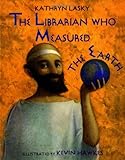The Solution to Reading Comprehension
Lessons & Units :: The Librarian Who Measured the Earth 3rd Grade Unit
Paired Text Questions: "The Earth as a Whole" and The Librarian Who Measured the Earth
Lesson Plan
The Librarian Who Measured the Earth | AD840L

- Learning Goal
- Integrate information from the non-fiction passage “The Earth as a Whole” and the book The Librarian Who Measured the Earth to recognize the connection between making observations and drawing conclusions.
- Necessary Materials
- Provided:
- Questions
- Non-fiction reading passage “The Earth as a Whole”
Not Provided:
The Librarian Who Measured the Earth
- Questions 1 and 2 refer to the non-fiction passage “The Earth as a Whole”. Questions 3 and 4 refer to the book The Librarian Who Measured the Earth. Questions 5 and 6 refer to both the passage and the book.
- Student versions of the questions are in the 'Texts & Materials' tab.
Part 1: "The Earth as a Whole"
Read the passage “The Earth as a Whole” out loud to your students. Alternatively, students can read the passage independently or as a group.
Question 1: If you make a little paper boat and let it sail flat across your desk, what happens when it crosses the edge? Additionally, if you make a little paper boat and let it sail around a globe, what happens as it moves farther and farther away from you?
Sample student answer: The boat falls down all at once when it crosses the edge. The boat disappears little by little as it moves farther and farther away.
Question 2: If real boats disappear little by little when they sail away, what does that tell you about the shape of the earth?
Sample student answer (may vary, but should resemble the following):
- It shows that the shape of the earth is a globe.
- It shows that the shape of the earth is round, not flat.
Part 2: The Librarian Who Measured the Earth
Question 3: On June 21st at midday, what did the sun do in Syene? Additionally, what did the sun do at the same time in Alexandria?
Sample student answer: The sun shone directly down a well without casting shadows on June 21st at midday. In Alexandria, the sun cast shadows.
Question 4: Based on this information, what did Eratosthenes know?
Sample student answer: Eratosthenes knew the earth was round.
If students ask how Eratosthenes knew the earth was round, reread the explanation in the book on page 38: “If the earth were flat, the sun would strike every place at the same angle and the shadows would all be exactly the same.”
Part 3: “The Earth as a Whole” and The Librarian Who Measured the Earth
Question 5: What do the passage and the book prove about the shape of the earth?
Sample student answer: The passage and the book prove that the shape of the earth is round.
Question 6: Is it better to learn the shape of the earth by making observations on your own or by believing what you are told? Explain why.
Sample student answer (may vary):
- It’s better to learn the shape of the earth by making observations on your own. That way you can see for yourself what is correct.
- It’s better to learn the shape of the earth by believing what you’re told. Making observations on your own takes too much time and trouble.
Texts & Materials
Standards Alignment
(To see all of the ReadWorks lessons aligned to your standards, click here.)



Good!
Great materials
Awesome!